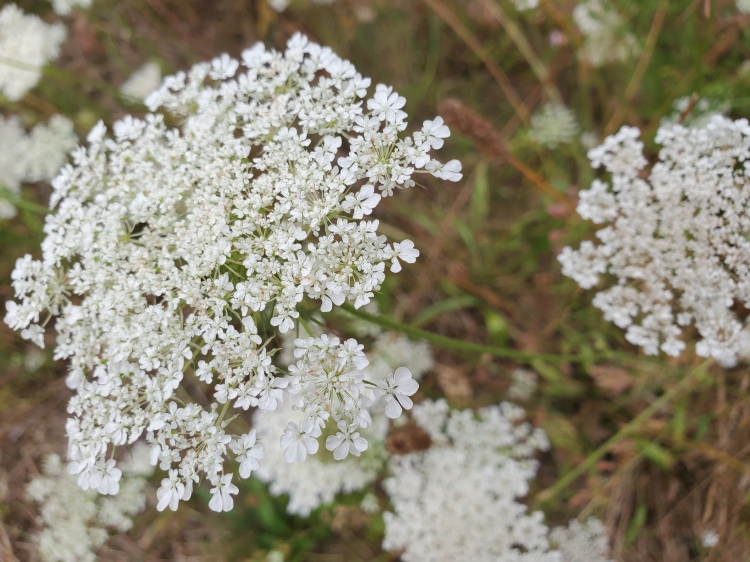I have come across them in many open fields during the summer. I had thought they were just pretty wild flowers until one day, I decided to find out what they are since they are so common here.
That’s when my I realized these white flowers are daucus carota, colloquially known as wild carrot flowers, commonly called Queen Anne’s Lace here. The flower resembles intricate laces and is thought to be named after Queen Anne of Great Britain, who is a very good lace maker. The story goes that the red spot in the middle of the flower represents a blood droplet when Queen Anne accidentally pricked herself when making a lace, an item of luxury at that time.

Like its cultivated cousin, the wild carrot flowers bloom when a carrot is unharvested, usually through winter in the ground. However, while its roots are edible when young, they tend to be very woody and not palatable. The carrot flowers can be eaten as it is (they taste good in salads). Slightly battered and deep fried carrot flowers are sometimes considered a delicacy.
However, I would strongly caution against picking these flowers to eat because they resemble the toxic wild hemlock which is also part of the carrot family, and can be found here as well. The poison hemlock is the plant that Socrates was made to drink as his punishment, and which killed him almost instantly. The plant is also toxic to the skin and can affect your respiratory and nervous system. One individual here was known to have severe reaction because she pulled the poison hemlock with her bare hands.

How do you tell the two different species of carrot flowers apart? First, while both have hollow stems, the wild carrot flower has a hairy stem, but the poison hemlock has a smooth stem with purple spots. The leaves of the wild carrot flower is also hairy, while that of poison hemlock is smooth.
Secondly, while both have umbrella-shaped flowers, the Queen Anne’s Lace often has a small red flower in the middle, but there is none in poison hemlock. Queen’s Anne Lace tends to have a flat top but the poison hemlock is more rounded.

Finally, Queen Anne’s lace has 3-pronged bracts appearing at both the base of the flowers and the main umbel. This is absent in poison hemlock.
Overall, the poison hemlock is much taller, growing up to 10 feet, while the wild carrots generally grow up to only 1 to 2 feet high. The wild carrots too, appear later in summer peaking in July and August, while the poison hemlock bloom as early as spring.

Queen Anne’s Lace is found in many places in the United States, although it is native to Europe. Essential oil from wild carrots is commonly used in lip balms , skin creams and anti-wrinkle creams. Some Native American tribes used the wild carrots to help treat snake bites. American settlers boiled the roots and occasionally used them in wine.
Interestingly, wild carrot flowers have the second highest sugar content among root vegetables (after beetroot). The root of the wild carrot flower can be used in making soups, stews and tea.
In Washington state, Queen’s Anne Lace is considered a noxious weed. However, in other places it is regarded as a beneficial weed. For example, it is known to boost tomato plant production when kept nearby.
Citations
https://www.garden.eco/carrot-flowers-pretty-edible-grow-seeds
https://forestgardenblog.wordpress.com/2017/02/17/against-the-odds-carrot-flowers/
https://www.livescience.com/21496-5-edible-garden-weeds.html
https://www.gardeningknowhow.com/ornamental/flowers/queen-annes-lace/queen-annes-lace-plant.htm
https://www.ediblewildfood.com/queen-annes-lace.aspx
https://www.survivalsullivan.com/wild-carrots-queen-anns-lace/
